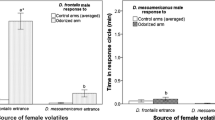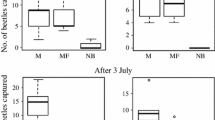Abstract
Chemical communication of the four-eyed fir bark beetle Polygraphus proximus Blandf., an aggressive invasive pest of the Siberian fir Abies sibirica Ledeb., was experimentally studied using a four-way olfactometer of a modified design, in which the tested insects were allowed to move on their own from a lightproof plastic container onto the lighted arena. Young hibernated adults of P. proximus were offered four variants of odor: fir log segments infested with (1) 10 males, (2) 10 females, (3) 10 couples of P. proximus, and (4) clean air as the control. The pheromone of P. proximus was shown to be produced by females; a similar response of both sexes characterized it as an aggregation pheromone. All the three variants with infested fir logs were much more attractive than the control variant with clean air. Volatiles from fir tissues not only seem to serve as markers facilitating host selection by the first-to-arrive beetles before direct contact with the tree bark, but also to be used as pheromone precursors or synergists. The absence of difference in response to the logs infested with males and couples of the bark beetle indicated that pheromone synthesis was inhibited after couple formation.
Similar content being viewed by others
References
Baranchikov, Yu.N. and Krivets, S.A., “On the Importance of Expertise in Insect Identification: How the Appearance of a New Aggressive Fir Pest in Siberia was Overlooked,” in Ecology of Southern Siberia and Adjacent Territories. Issue 14, Vol. 1 (Khakass State Univ., Abakan, 2010), pp. 50–52 [in Russian].
Benjamini, Y. and Yekutieli, D., “The Control of the False Discovery Rate in Multiple Testing under Dependency,” Annals of Statistics 29 (4), 1165–1188 (2001).
Blomquist, G.J., Figueroa-Teran, R., Aw, M., Song, M., Gorzalski, A., Abbott, N.L., et al., “Pheromone Production in Bark Beetles,” Insect Biochemistry and Molecular Biology 40, 699–712 (2010).
Bowers, W.W. and Borden, J.H., “Evidence for a Male-Produced Aggregation Pheromone in the Four-Eyed Spruce Bark Beetle, Polygraphus rufipennis (Kirby) (Col., Scolytidae),” Journal of Applied Entomology 110, 292–299 (1990).
Kerchev, I.A., “On Monogyny of the Four-Eyed Fir Bark Beetle Polygraphus proximus Blandf. (Coleoptera, Curculionidae: Scolytinae) and Its Reproductive Behavior,” Entomologicheskoe Obozrenie 93 (3–4), 518–526 (2014a) [Entomological Review 94 (8), 1059–1066 (2014)].
Kerchev, I.A., “Ecology of Four-Eyed Fir Bark Beetle Polygraphus proximus Blandf. (Coleoptera: Curculionidae, Scolytinae) in the West Siberian Region of Invasion,” Rossiiskii Zhurnal Biologicheskikh Invazii, No. 2, 80–94 (2014b) [Russian Journal of Biological Invasions 5 (3), 176–185 (2014)].
Kerchev, I.A., “Description of the Stridulatory Apparatus of the Far Eastern Bark Beetles Polygraphus proximus Blandford, 1894 and P. jezoensis Niisima, 1909 (Coleoptera, Curculionidae: Scolytinae),” Entomologicheskoe Obozrenie 94 (4), 818–825 (2015) [Entomological Review 95 (9), 1191–1196 (2015)].
Kirkendall, L.R., “The Evolution of Mating Systems in Bark and Ambrosia Beetles (Coleoptera: Scolytidae and Platypodidae),” Zoological Journal of the Linnean Society 77, 293–352 (1983).
Kirkendall, L.R., Kent, D.S., and Raffa, K.F., “Interactions among Males, Females and Offspring in Bark and Ambrosia Beetles: Significance of Living in Tunnels for the Evolution of Social Behavior,” in The Evolution of Social Behavior in Insects and Arachnids, Ed. by J.C. Choe and B.J. Crespi (University Press, Cambridge, 1997), pp. 181–215.
Kirkendall, L.R., Biedermann, P.H.W., and Jordal, B., “Evolution and Diversity of Bark and Ambrosia Beetles,” in Bark Beetles. Biology and Ecology of Native and Invasive Species, Ed. by F.E. Vega and R.W. Hofstetter (Academic Press, Oxford, 2015), pp. 85–156.
Krivets, S.A., Kerchev, I.A., Bisirova, E.M., Demidko, D.A., Petko, V.M., and Baranchikov, Yu.N., “Distribution of the Four-Eyed Fir Bark Beetle Polygraphus proximus Blandf. (Coleoptera, Curculionidae: Scolytinae) in Siberia,” in Proceedings of the Forest Technical Academy, Issue 211 (St. Petersburg, 2015), pp. 33–45 [in Russian].
Leahy, M.J.A., Oliver, T.H., and Leather, S.R., “Feeding Behavior of the Black Pine Beetle, Hylastes ater (Coleoptera: Scolytidae),” Agricultural and Forest Entomology 9, 115–124 (2007).
Lindgren, B.S. and Raffa, K.F., “The Evolution of Tree Killing by Bark Beetles: Trade-offs between the Maddening Crowds and a Sticky Situation,” Canadian Entomologist 145, 471–495 (2013).
McIndoo, N.E., “An Insect Olfactometer,” Journal of Economic Entomology 19, 545–571 (1926).
Nobuchi, A., “Bark-Beetles Injurious to Pine in Japan,” Bulletin of the Government Forest Experiment Station 185, 1–50 (1966) [in Japanese with English summary].
Ohmart, C.P., “Why Are There So Few Tree-Killing Bark Beetles Associated with Angiosperms?” Oikos 54 (2), 242–245 (1989).
Pettersson, J., “An Aphid Sex Attractant. I. Biological Studies,” Entomologia Scandinavica 1, 63–73 (1970).
Pope, T.W., Girling, R.D., Staley, J.T., Trigodet, B., Wright, D.J., Leather, S.R., Van Emden, H.F., and Poppy, G.M., “Effects of Organic and Conventional Fertilizer Treatments on Host Selection by the Aphid Parasitoid Diaeretiella rapae,” Journal of Applied Entomology 136, 445–455 (2012).
Raffa, K.F., Gregoire, G.-C., and Lindgren, B.S., “Natural History and Ecology of Bark Beetles,” in Bark Beetles. Biology and Ecology of Native and Invasive Species, Ed. by F.E. Vega and R.W. Hofstetter (Academic Press, Oxford, 2015), pp. 1–28.
Raldugin, V.A., “Fir Triterpenoids and a Highly Effective Plant Growth Regulator Based on Them,” Rossiiskii Khimicheskii Zhurnal 48 (3), 84–88 (2004).
Rudinsky, J.A., Oester, P.T., and Ryker, L.C., “Gallery Initiation and Male Stridulation of the Polygamous Spruce Bark Beetle Polygraphus rufipennis Kirby,” Annals of the Entomological Society of America 71, 317–321 (1978).
Ryker, L.C., “Acoustic Studies of Dendroctonus Bark Beetles,” Florida Entomologist 71 (4), 447–461 (1988).
Tokuda, M., Shoubu, M., Yamaguchi, D., and Yukawa, J., “Defoliation and Dieback of Abies firma (Pinaceae) Trees Caused by Parendacus abietinus (Coleoptera: Curculionidae) and Polygraphus proximus (Coleoptera: Scolytidae) on Mountain Unzon, Japan,” Applied Entomology and Zoology 43 (1), 1–10 (2008).
Author information
Authors and Affiliations
Corresponding author
Additional information
This article was originally submitted by the authors in Russian and is first published in translation.
Rights and permissions
About this article
Cite this article
Kerchev, I.A., Pousheva, M.S. Olfactometric evidence for aggregation pheromone production by females of the four-eyed fir bark beetle Polygraphus proximus Blandf. (Coleoptera, Curculionidae: Scolytinae). Entmol. Rev. 96, 821–825 (2016). https://doi.org/10.1134/S0013873816070010
Received:
Published:
Issue Date:
DOI: https://doi.org/10.1134/S0013873816070010




